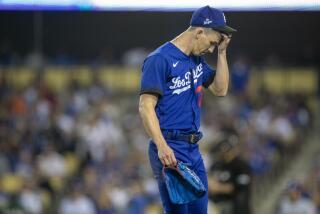Angels pitcher C.J. Wilson hasn’t eradicated erratic tendencies
- Share via
C.J. Wilson seems amused by reporters who try to analyze him, or, as he puts it, “get inside my head.” Approached after a loss to Cincinnati in his first start, the Angels left-hander quipped, “Here come the sports psychologists.”
Of course, Wilson tends to invite questions about his mental approach because his results often don’t seem to match up with his array of what the Angels consider to be better-than-average pitches — a 92-mph four-seam fastball, a lively two-seam fastball, a slider, cut-fastball, curve and changeup.
Wilson, who will start Tuesday night’s home opener against the Oakland Athletics, baffled the Angels during an erratic 2012 season, his first with the club after signing a five-year, $77.5-million deal.
Wilson had a 9-5 record and 2.43 earned-run average during a first half in which he made the All-Star game, and a 4-5 record and 5.54 ERA during a second half that included an 11-start winless streak and an epic Aug. 18 meltdown in which he failed to hold an 8-0 lead in a 10-8 loss to Tampa Bay.
Despite repeated questions about his health, neither he nor the team disclosed that Wilson’s elbow began bothering him in July. After his last start of the season, Wilson revealed he would undergo surgery to remove bone spurs.
But his first start of 2013 was again perplexing.
After retiring the first 10 Reds batters, Wilson, in a span of five hitters and 21 pitches, gave up four runs. Chris Heisey walked on four pitches, Joey Votto walked and Brandon Phillips hit a three-run home run. Jay Bruce doubled and scored on Todd Frazier’s single, and the Reds were on their way to a 5-4 victory.
The performance was the continuation of a difficult-to-explain trend in which Wilson pitches like an All-Star the first time through the order, a batting-practice pitcher the second time through and — should he get so far — a Cy Young Award candidate the third time through.
Opponents hit .203 with a .318 on-base percentage, .297 slugging percentage, five home runs, nine doubles and 16 runs in their first plate appearances against Wilson last season.
The second time through the order, those numbers jumped to .298/.360/.454 with nine homers, 10 doubles and 46 runs. But the third time through, the numbers fell to .188/.276/.307 with five homers, seven doubles and 26 runs.
“There’s no theory behind it, nothing that says this is why, because generally speaking the third time through is the toughest,” Angels pitching coach Mike Butcher said. “To me, there is no answer.”
Nor is there reason to make an issue of it, he added.
“It’s like Ervin Santana a few years ago with his home-road splits,” Butcher said. “Sometimes things are just unexplainable, and the more you tinker with it or bring it to their attention, the worse it gets.”
Manager Mike Scioscia noticed the trend in the second half of last season.
“What’s kind of puzzling is that’s what you might see with some guys who are not as multidimensional as C.J.,” Scioscia said. “Guys who are one- or two-dimensional — say they only throw a sinker and slider — the second time hitters see them, they can’t go to other things. But C.J. has so many things he can do, he should be able to give hitters different looks three or four times a game.”
Wilson said he lost his release point in the 40-degree temperatures at Great American Ball Park last week, but like Butcher and Scioscia, he struggled to pinpoint a broader reason for why he’s been hit hard the second time through the order.
“It might be a combination of feeling amped up, trying to do too much, and having the adrenaline wear off a bit,” Wilson said. “Also, if you strike a guy out the first time, he’s definitely going to make an adjustment. If you get him on a ground ball or popup, he might not make an adjustment. There’s an art to not showing all of your pitches right away. That’s something I’m working on.”
One theory is that Wilson has too many pitches, which can lead to indecision over selection, and that he’d be better off streamlining his repertoire. If Wilson had one dominant pitch, he might agree with that, but he likes the luxury of choosing which pitches are working best on a given day and focusing on them.
“Mariano Rivera has the great cutter, R.A. Dickey has a great knuckleball, Sandy Koufax had a great fastball and curve, but I’ve never had one pitch that was that much better than the rest of them,” Wilson said.
“Some guys, their stuff is so good they can go one or two times through the order with one pitch before they have to go to something else. I usually need at least two pitches to get through the order the first time.”
twitter.com/MikeDiGiovanna
More to Read
Go beyond the scoreboard
Get the latest on L.A.'s teams in the daily Sports Report newsletter.
You may occasionally receive promotional content from the Los Angeles Times.











